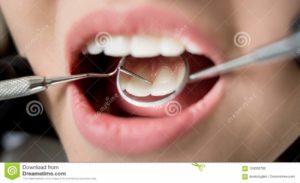
Diagnosed with Cancer? Your two greatest challenges are understanding cancer and understanding possible side effects from chemo and radiation. Knowledge is Power!
Learn about conventional, complementary, and integrative therapies.
Dealing with treatment side effects? Learn about evidence-based therapies to alleviate your symptoms.
Click the orange button to the right to learn more.
- You are here:
- Home »
- Blog »
- side effects ID and prevention »
- Xerostomia- Tooth Enamel
Xerostomia- Tooth Enamel

“Xerostomia, also known as dry mouth,[1] is dryness in the mouth, which may be associated with a change in the composition of saliva, or reduced salivary flow, or have no identifiable cause.”
I developed xerostomia when I underwent radiation to my single bone plasmacytoma (SBP) in my fifth cervical vertebra aka C5. While this side effect is most common in head and neck cancer patients who undergo radiation, as you can see from my experience, it can happen to anyone who undergoes radiation to their neck or lower face area.
How can I strengthen my tooth enamel?
- Maintain good oral hygiene:
- Brush your teeth twice a day using fluoride toothpaste. Fluoride helps to strengthen enamel.
- Use a soft-bristled toothbrush to avoid damaging the enamel or causing gum recession.
- Floss regularly:
- Flossing helps remove plaque and food particles between your teeth and along the gumline, preventing decay and strengthening enamel.
- Limit acidic foods and beverages:
- Acidic foods and drinks, such as citrus fruits, sodas, and certain juices, can erode enamel. Limit your intake and rinse your mouth with water afterward.
- Drink water:
- Water helps neutralize acids in the mouth and promotes saliva production, which aids in remineralizing enamel.
- Use fluoride mouthwash:
- Rinse with a fluoride-containing mouthwash to strengthen enamel and provide additional protection against cavities.
- Chew sugar-free gum:
- Chewing sugar-free gum stimulates saliva production, which helps neutralize acids and remineralize enamel. Look for gum with xylitol, a sugar substitute that may have additional benefits for dental health.
- Consume calcium-rich foods:
- Calcium is essential for strong teeth. Include dairy products, leafy greens, almonds, and other calcium-rich foods in your diet.
- Avoid teeth grinding:
- Grinding your teeth can wear down enamel. If you grind your teeth, consider using a mouthguard at night to protect them.
- Visit your dentist regularly:
- Regular dental check-ups allow your dentist to detect and address any enamel issues early. Professional cleanings and fluoride treatments can also help maintain strong enamel.
- Consider enamel-strengthening products:
- Some toothpaste and mouthwash products are specifically formulated to strengthen enamel. Look for products containing fluoride and hydroxyapatite, a compound that mimics the structure of enamel.
I consider xerostomia to be a sort of stealth side effect. Xerostomia does not occur immediately after you undergo radiation therapy. I didn’t notice anything happening in my mouth for more than eight (8) years after my radiation therapy. I was walking along the street one day when a filling fell out of a molar in the back of my mouth.
It took me awhile to figure out what was going on but I came to understand that the lack of saliva in my mouth was eroding my teeth.
While a loss of saliva production in your mouth is uncomfortable, in an of itself, a dry mouth isn’t really a health problem. We can debate how unhealthy bad breath is later…
As far as my own quality and quantify of life is concerned, my real issue is my teeth. The loss of the mouth’s ability to create saliva erodes the enamel on your teeth. No enamel, no teeth.
While the usual talking points for keeping your teeth healthy can help, xerostomia can advance faster than brushing, flossing, etc. can help.
The study linked and excerpted below is the first time I have ever found a therapy that purports to actually re-mineralize tooth enamel.
My guess is that the re-mineralizing of tooth enamel isn’t available in your dentist’s offices. However, I think it is only a matter of time before this process is available. I am writing this post in 12/2022. I will keep you posted as I learn more.
In the meantime, please read more about the evidence-based, non-conventional therapies discussed in the xerostomia blog post linked below.
If you have any questions or comments scroll down the page, write a post and I will reply to you ASAP.
Thank you,
David Emerson
- Cancer Survivor
- Cancer Coach
- Director PeopleBeatingCancer
I have been researching and writing about xerostomia for years.
- Healing Radiation-Fibrosis- Xerostomia aka Dry Mouth
- Acupuncture – Dry Mouth – Head/Neck Cancer
- The Cancer Side Effects Program
- Multiple Myeloma- Xerostomia-Dry Mouth
Xerostomia
“Dehydration, radiotherapyinvolving the salivary glands, chemotherapy and several diseases can cause reduced salivation (hyposalivation), or a change in saliva consistency and hence a complaint of xerostomia…
Signs and symptoms[edit]
- Dental caries (xerostomia related caries) – Without the buffering effects of saliva, tooth decay becomes a common feature and may progress much more aggressively than it would otherwise (“rampant caries”). It may affect tooth surfaces that are normally spared, e.g., cervical caries and root surface caries. This is often seen in patients who have had radiotherapy involving the major salivary glands, termed radiation-induced caries.[9] Therefore, it is important that any products used in managing dry mouth symptoms are sugar-free, as the presence of sugars in the mouth support the growth of oral bacteria, resulting in acid production and development of dental caries.[8]
A New Discovery Can Help Restore Tooth Enamel
“Tooth enamel can be restored by adding a complex of amino acids to the mineralized material hydroxyapatite, discovered through joint research by scientists at Ural Federal University, Voronezh State University, Voronezh State Medical University, Al-Azhar University, and the National Research Center (Egypt).
What to know:
- Tooth enamel has a protective function, but its integrity can be destroyed by abrasion, erosion, or microfractures to a point that if the surface of the tissue is not repaired in time, the enamel lesion will affect the dentin and then the pulp of the tooth.
- Current tooth restorative techniques involve acid etching of the enamel to increase the bonding effect, which sometimes leaves behind products which may not always have a positive effect on the bonding of enamel and synthetic materials.
- Hydroxyapatite is a compound that is a major component of human bones and teeth and mixing it with polyfunctional organic and polar amino acids can create a dental coating that replicates the composition and microstructure of natural tooth enamel.
- The new method of dental restoration can be used to reduce the sensitivity of teeth in case of enamel abrasion or to restore it after erosion.
- The new composition material duplicates the features of the surface of the tooth at the molecular and structural level and actually exceeds the strength of the native enamel.
Engineering of biomimetic mineralized layer formed on the surface of natural dental enamel
“Highlights
- Engineering of biomimetic mineralized layer on the surface of natural dental enamel.
- The effect of pretreatment of the tooth enamel surface.
- Formation of mineralized layer with homogeneous micromorphology and preferential orientation of ncHAp nanocrystals…
Conclusions
In our work we have demonstrated that with the use of nanocrystalline carbonate-substituted calcium hydroxyapatite (HAp), a calcium alkali, and a complex of polyfunctional organic and polar amino acids, a biomimetic mineralized layer can be formed on the surface of the dental natural tissue (biotemplate).
The formation of a mineralized layer with properties resembling those of natural hard tissue was confirmed by the results of field emission electron and atomic force microscopy, also chemical imaging of the surface areas with help of Raman microspectroscopy. The thickness of the biomimetic mineralized layer varies from 300 to 500 nm, while the direction of some ncHAp nanocrystals coincides with that of apatite crystals in the enamel. We also demonstrated that the engineered mineralized HAp layer was characterized by homogeneous micromorphology and enhanced nanohardness in the region of the enamel rods exceeding that of native enamel.
Obtaining a mineralized layer with a similar hierarchy and cleavage characteristic of natural enamel, taking into account the peculiarities of micromorphology of dental tissue, is an urgent problem for future research.
The development of a strategy for biomimetic engineering and a technique for enamel surface pre-treatment in order to provide tissue mineralization has a huge potential for application in dental clinic practices…”


